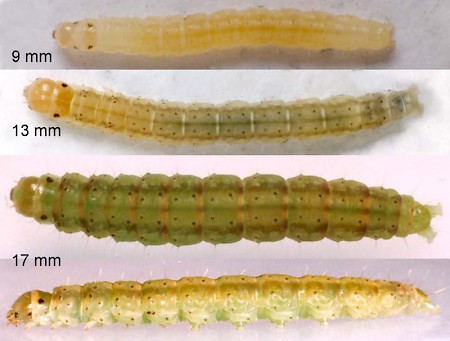32.017 BF697
Agonopterix arenella
([Denis & Schiffermüller], 1775)
Wingspan 19-23 mm.
The posture of this moth is typical of many of the Depressariinae, which rest with flattened, overlapping wings.
This species hatches in the autumn and spends the winter as an adult.
Occurring throughout Britain, it is a nocturnal flier and is attracted to light. The larvae feed on various thistles (Carduus) and knapweed (Centaurea).
- Larva: (description Ian F. Smith):
Foodplants: May - early August. Initially in a leaf mine. Later under silk, often in a leaf furrow, or leaf rolled down. On Carduus, Cirsium, Centaurea, Arctium, Serratula and, on mainland Europe, onCarlina, Sonchus and Knautia. Usually the commonest Agonopterix sp. On most of these plants.
Early instar larva
Length: 9 mm described on the point of ecdysis.
Head: Brownish yellow with darker mandibles.
Prothoracic shield: Yellow with prominent dark brown lateral spot. (Photograph shows a second set of spots on cuticle being shed from head.)
Body: Whitish, tinted yellow dorsally.
Pinacula: Concolorous. Setal spot slightly darker.
Setae: Colourless transparent.
Anal plate: Concolorous.
Prolegs: Concolorous.
Intermediate instar larva
Length: 13 mm described
Head: Yellowish brown. Stemmatal area blackish.
Prothoracic shield: Light brown with bold pitchy black lateral spot.
Body: Dull brownish yellow. Translucent, with viscera showing as dark shadow dorsally. Paler ventrally. Brownish dorsal line and dorso-lateral line.
Pinacula: Blackish.
Setae: Translucent pale brown.
Anal plate: Concolorous.
Prolegs: Concolorous.
Late instar larva
Length: 17 mm, prepupation, described.
Head: Greenish brown. Mandibles darker. Frons greener. Pitchy brown postero-lateral mark. Stemmata joined by a black arc.
Prothoracic shield: Transparent light brown showing green of body below in posterior part. Bold pitchy black lateral spot.
Thoracic legs: Translucent pale brown.
Body: Green, strongest dorsally. Contractile dorsal vessel shows as a dark line, indistinct anteriorally. Broad brownish dorso-lateral line. Segments A9 and A10 lack lines. Reddish intersegmentally, probably denoting approaching pupation.
Spiracles: Gold ochre with brown peritreme.
Pinacula: Black.
Setae: Light brown.
Anal plate: Transparent partly tinted light brown, showing green interior of body.
Prolegs: Concolorous with venter.
Comment: The lateral spots on the prothoracic plate are distinctive.

 UKMoths
UKMoths 








